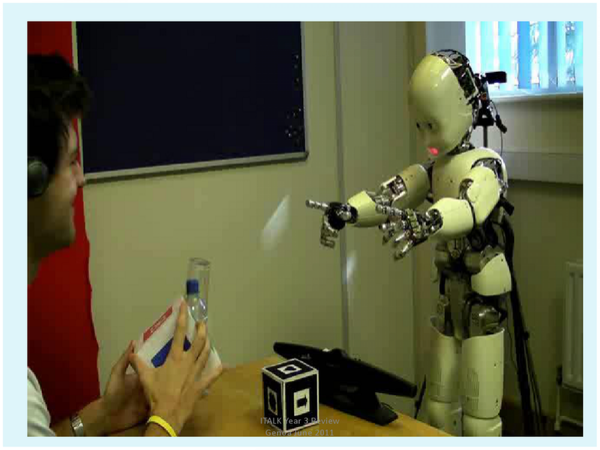Robot Grows Out Of Baby Talk, Thanks To Human Teachers

After conversing with a person for a few minutes, a robot's speech changed from random babbling into distinct word formations, mimicking the way that an infant learns to graduate from baby talk to intelligible conversation, researchers reported Wednesday.
In a paper appearing in the journal PloS ONE, University of Hertfordshire researchers describe how a robot named DeeChee, equipped with both speech-generation and speech-recognition capabilities, went from spouting random syllables to forming words such as red, green and cross.
DeeChee and its human teacher sat at a table with various colored blocks between them. A group of 34 participants, who were not researchers involved in the experiment, were encouraged to use their own words to try and teach the robot the names of colors and patterns. The robot would babble for four seconds, then listen for four seconds.
Volunteers were encouraged to talk to the robot as if it were a small child and offer reinforcement by smiling or saying things such as well done or clever. When it received positive reinforcement after uttering something like a word by chance, DeeChee added the word to its lexicon.
Some people were better teachers than others, the scientists said. Overpraising DeeChee led to some unwarranted positive reinforcement that caused the robot to erroneously utter nonsense words.
The authors say that interactions between robots and humans may help us better understand how we acquire language skills. But robots like DeeChee aren't equipped yet to cope with complex speech or to delineate between varying pronunciations of words.
Still, it is known that infants are sensitive to the frequency of sounds in speech, and these experiments show how this sensitivity can be modeled and contribute to the learning of word forms by a robot, the authors said in a statement Wednesday.
The researchers acknowledged that an eight-minute experiment cannot compare with the immersive learning environment most children have at home. But they did point to a set of experiments with human babies described in the journal Science in 1996, in which University of Rochester scientists found that 8-month-olds could recognize certain word segments after just two minutes of being exposed to speech.
An appropriate analogy for a robot language-learning experiment is with a situation where a carer is explicitly aiming to teach a child, for instance in a therapeutic setting, the University of Hertfordshire researchers wrote in PLoS ONE.
SOURCE: Lyon et al. Interactive Language Learning by Robots: The Transition from Babbling to Word Forms. PLoS ONE 7(6): e38236.
© Copyright IBTimes 2025. All rights reserved.




















